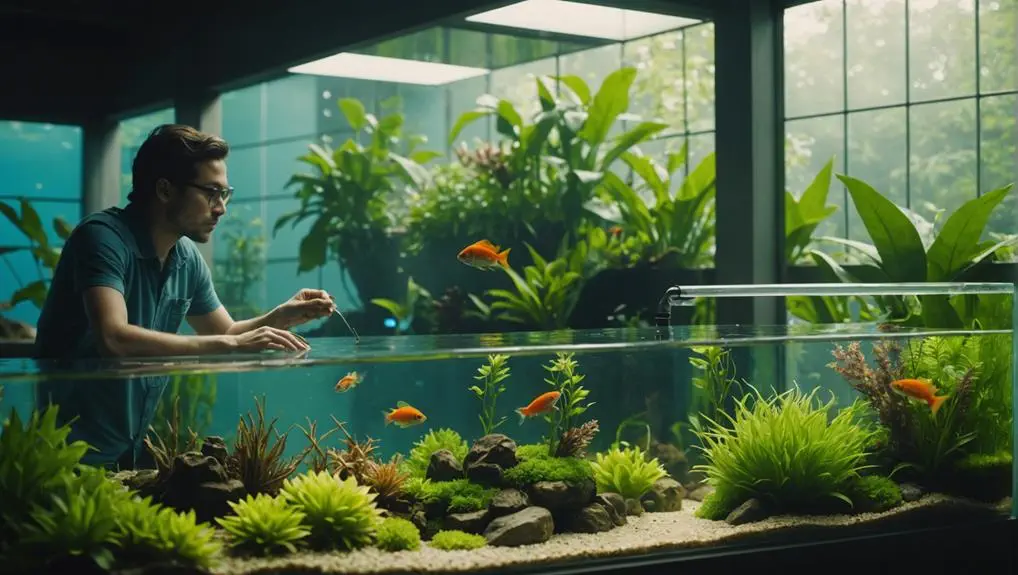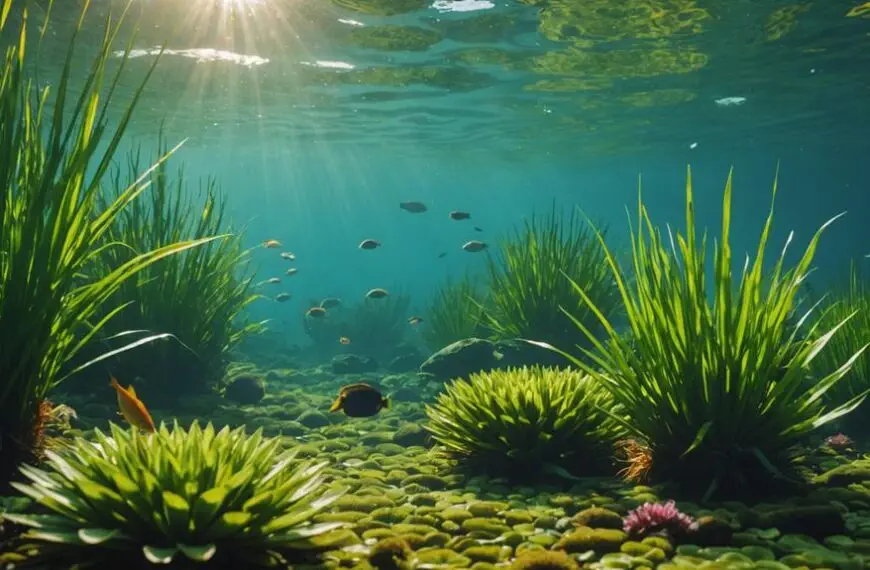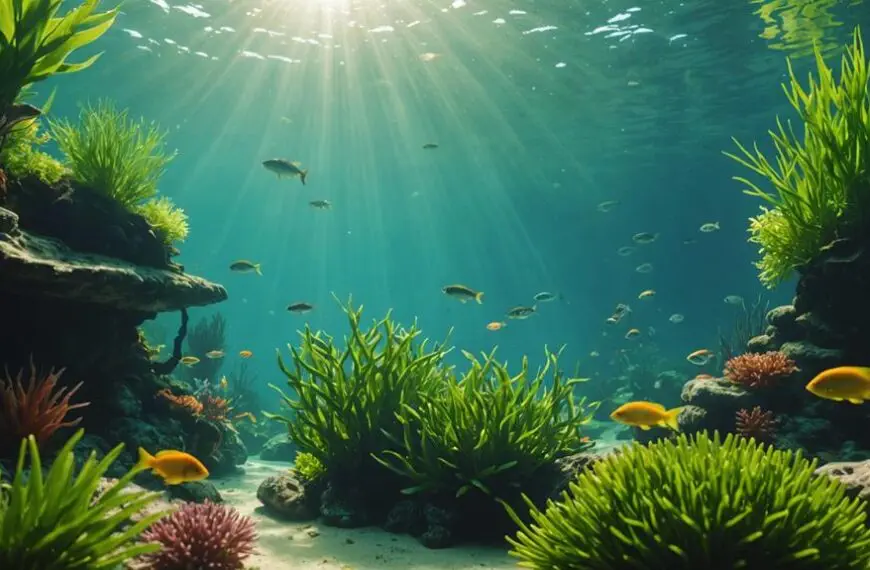Reducing your fishkeeping carbon footprint is super important for a healthier planet, and you can totally enjoy your aquarium while doing it! By managing energy and water use better, you're not just helping the environment; you're also saving some cash. Larger tanks can eat up a lot of energy, so smaller or energy-efficient setups can work wonders. Plus, choosing fish from sustainable sources shows you care about the planet, too! With a little effort, you can be a fishkeeping hero. Curious about some easy steps to get started? There's plenty more to explore that'll help you make a splash!
Contents
- 1 Understanding Fishkeeping Carbon Footprint
- 2 The Importance of Sustainability
- 3 Water Consumption in Aquariums
- 4 Energy Efficiency Practices
- 5 Choosing Sustainable Fish Sources
- 6 Waste Management Techniques
- 7 Community and Environmental Impact
- 8 Future of Sustainable Fishkeeping
- 9 Frequently Asked Questions
- 10 Final Thoughts
Understanding Fishkeeping Carbon Footprint
When it comes to understanding your fishkeeping carbon footprint, you might be surprised by how much it can vary. The carbon footprint of owning a tropical aquarium can range between 85.3kg and 635.2kg of CO₂-equivalent annually. That's a significant chunk of the average UK household emissions, accounting for 1.6% to 12.4%!
One of the biggest contributors to this environmental impact is the energy consumption needed to heat the water. Larger tanks need even more energy, which can make you think twice about your setup. Additionally, maintaining optimal water quality is crucial, as good practices can help minimize the energy used in filtration and heating, making it essential to maintain water quality effectively.
Water consumption estimates for tropical fishkeeping can also be pretty wild, ranging from 156 to a whopping 31,200 liters a year. It's essential to note that your maintenance practices play a huge role in this. Given that around 70% of UK fish owners keep tropical freshwater aquariums, this adds up!
But don't fret—there are sustainable practices you can adopt. By using renewable energy sources and optimizing your water changes, you can make a real difference in reducing the environmental impact of your hobby.
The Importance of Sustainability
When it comes to fishkeeping, being aware of your ecological footprint is super important.
You mightn't realize it, but your aquarium can munch up a lot of energy and water, which adds up to some serious environmental impact. Maintaining optimal water quality is essential not only for the health of your fish but also for reducing the resources consumed in the process; healthy fish can live longer with proper care, leading to less frequent replacements.
Ecological Footprint Awareness
Understanding your ecological footprint is crucial for making sustainable choices in fishkeeping. Every decision you make impacts the planet, and being aware of your fishkeeping habits can guide you toward more responsible practices.
Tropical aquariums can contribute significantly to carbon emissions, accounting for 1.6% to 12.4% of average UK household CO₂ emissions. That's a big deal!
Here are three key areas to consider for reducing your environmental impact:
- Water Consumption: Tropical tanks can use between 156 and 31,200 liters of water annually. Efficient water management is essential.
- Sustainable Practices: Utilizing renewable energy and minimizing water changes can help lessen your carbon footprint.
- Comparative Impact: Keeping tropical fish generally has a smaller carbon footprint than owning pets like dogs or cats.
Energy Consumption Management
Managing energy consumption is vital for sustainable fishkeeping practices. When you maintain tropical aquariums, you mightn't realize that your energy use can contribute significantly to carbon emissions—up to 12.4% of an average UK household's CO₂ emissions, in fact! This is where your efforts can make a real difference.
By using timers for aquarium lights and pumps, you can cut down on energy consumption, saving both electricity costs and reducing those pesky emissions.
And here's a tip: keeping your aquarium at the lower end of your fish's temperature needs not only boosts their health but also saves energy.
Consider transitioning to renewable energy sources, too. Not only does this lower your environmental impact, but it also sets a great example for others in the fishkeeping community.
Every small change counts, so think of it as your way of serving the planet while enjoying your underwater world. After all, who doesn't want to be a superhero for the environment?
With a few adjustments, you can turn your passion for fishkeeping into a sustainable hobby that benefits both your aquatic friends and our Earth!
Responsible Pet Ownership
Sustainable pet ownership is essential for minimizing our environmental impact, and fishkeeping is no exception.
By being responsible fish owners, you can significantly lower the environmental impacts of keeping tropical aquariums. Did you know aquariums can contribute up to 12.4% of average household carbon dioxide emissions? That's a hefty number!
But don't worry; there are simple ways to be more eco-friendly.
Here are three sustainable practices you can adopt:
- Use renewable energy: Power your aquarium with green energy. It's a great way to cut down on carbon dioxide emissions produced while keeping your fish happy!
- Optimize water usage: Managing your average household water usage is key. Consider water recycling methods to keep that fish tank clean without wasting precious resources.
- Schedule maintenance wisely: Regular maintenance not only keeps your tank healthy but can also help you minimize your fishkeeping carbon footprint.
Water Consumption in Aquariums
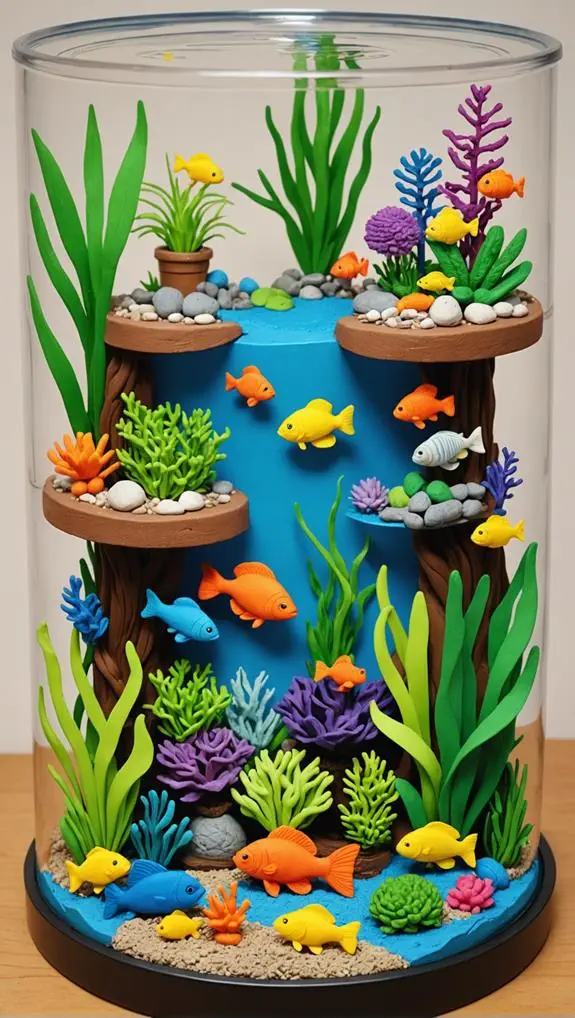
When you're setting up your aquarium, it's easy to overlook just how much water you're actually using.
Did you know that even a small 50-liter tank can waste about 156 liters of water every year?
Let's chat about some smart, sustainable maintenance practices that can help keep your fish happy while also being kinder to our planet's precious resources.
Water Usage Estimates
Understanding water usage in aquariums is crucial for reducing your fishkeeping carbon footprint. You mightn't realize it, but tropical aquariums can consume between 156 and 31,200 liters of water annually! That's a huge range, and even a 50-liter tank can use around 156 liters each year.
When you think about it, regular maintenance practices—like water changes—can really add up. These actions not only generate waste but also increase your overall water consumption.
Plus, using reverse osmosis systems can produce five liters of reject water for every liter you purify. Talk about a water efficiency conundrum!
Here are a few eye-opening facts about water usage in your aquariums:
- Water usage can account for 0.2% to 30.1% of the average UK household's total water consumption.
- Keeping fish is rewarding, but it can have a significant environmental impact.
- Every drop counts—be mindful of your water consumption!
Sustainable Maintenance Practices
Maintaining your aquarium with sustainability in mind can significantly reduce your water consumption and environmental impact. You mightn't realize just how much water your tropical aquarium uses, contributing to up to 30.1% of a household's water consumption. That's a lot!
To help, consider your water changes. Instead of changing the water on a whim, wait until it's truly needed. This efficient management can save you gallons while keeping your fish happy.
If you're using a reverse osmosis system, be aware it can produce five liters of reject water for every liter you purify. That's a lot of waste we can avoid! Emphasizing water sustainability is vital, especially as climate change continues to challenge our resources.
Incorporating these sustainable maintenance practices not only helps the environment but also makes you a responsible fishkeeper. You're not just caring for your aquatic friends; you're serving the planet, too.
Energy Efficiency Practices
Adopting energy efficiency practices in your aquarium can lead to significant reductions in both energy bills and your carbon footprint. By making a few simple changes, you can help the environment while keeping your tank thriving. Here are some effective strategies:
– Lower water temperatures: Maintain your aquarium at the cooler end of your fish's temperature range. This can significantly reduce energy consumption since heating water is a major emissions factor.
Additionally, keeping your water temperature stable helps maintain optimal conditions for your fish's health.
- Use timers: Set timers for your aquarium lights and pumps. This ensures they only run when needed, helping to minimize overall energy usage.
- Switch to energy-efficient equipment: Consider using LED lighting and energy-saving pumps. These upgrades not only save you money but also contribute to lower carbon emissions over time.
Don't forget about regular maintenance of your aquarium systems! Keeping everything in good shape ensures they operate efficiently, reducing unnecessary energy consumption.
You can even explore renewable energy sources to power your tank—your fish will thank you while you shrink your carbon footprint.
Choosing Sustainable Fish Sources
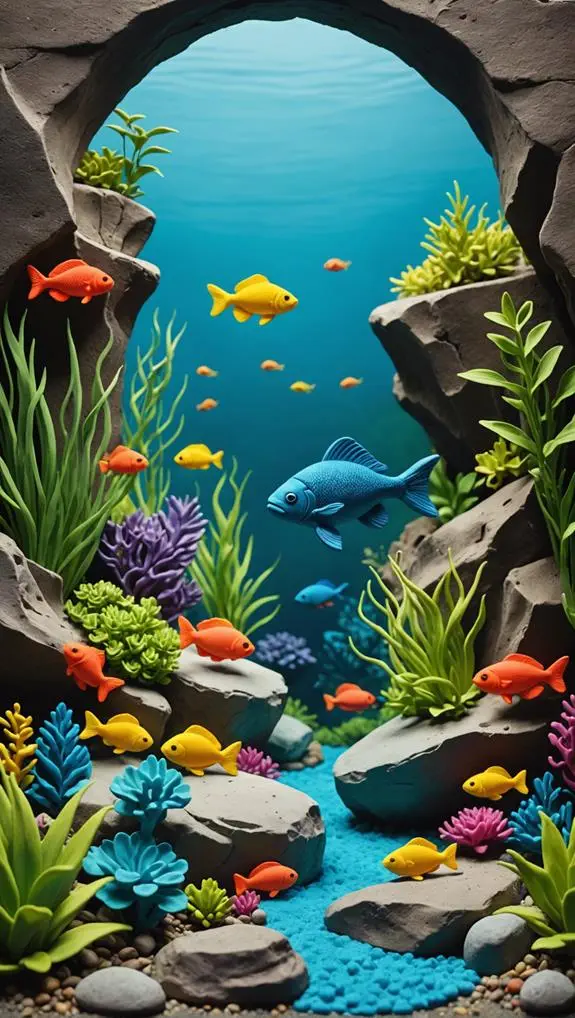
Choosing sustainable fish sources is crucial for reducing your aquarium's carbon footprint. By picking fish from certified sustainable fisheries, you help ensure that these practices minimize environmental impacts and overfishing. Isn't it nice to know your choices can make a difference?
When you opt for fish grown in eco-friendly aquaculture systems, you're not just being kind to the ocean; you're also supporting methods that use renewable energy and sustainable feed. This means lower carbon emissions—win-win!
Plus, consider species like tilapia and catfish, which have a smaller carbon footprint compared to those fuel-hungry shrimp and crab.
Don't forget about local fish! Sourcing from nearby means shorter transportation distances, which cuts down on those pesky transportation emissions. Who knew that a little fish could swim a shorter route to your tank?
Waste Management Techniques
Effective waste management techniques are essential for creating a thriving aquarium while minimizing your carbon footprint.
By implementing smart practices, you not only help your fish but also the planet!
Here are a few tips to get you started:
- Regular water changes are key, but you can cut down on water consumption by monitoring your feeding strategies. This helps reduce uneaten food waste, keeping ammonia and nitrate levels low.
- Consider using timers for your aquarium lights and pumps. This not only saves on energy needs but also maintains stable water conditions, reducing the frequency of water changes.
- Don't forget about recycling practices! Recycled reject water from your filtration system can be repurposed for your garden, giving life to your plants while minimizing environmental impact.
Community and Environmental Impact
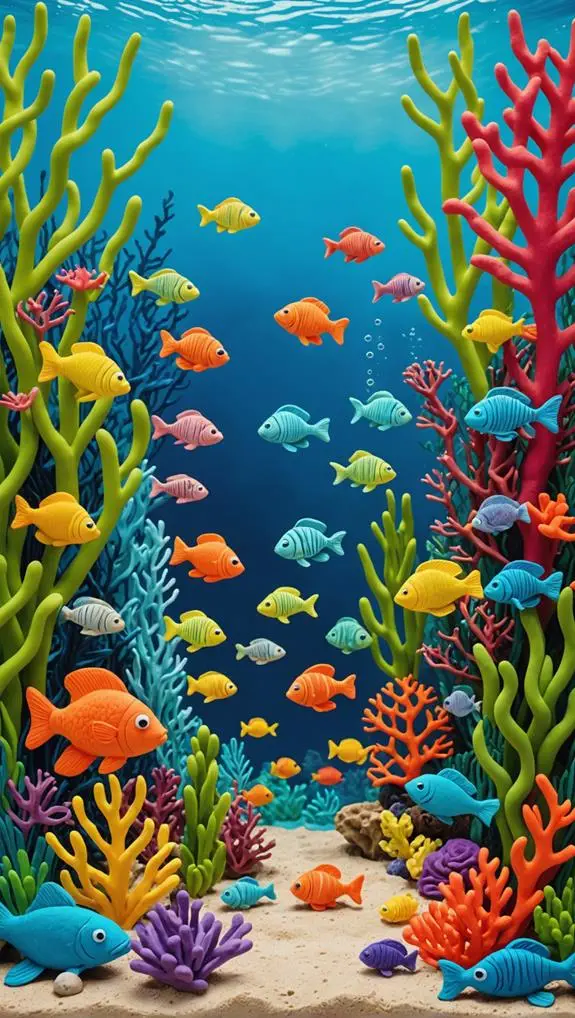
Your aquarium's impact extends beyond the glass walls and into the community and environment. When you keep fish, you're part of a larger tapestry that affects local ecosystems.
Did you know that tropical aquariums contribute about 12.4% to the average UK household's CO₂ emissions? With around 4 million households keeping fish, that's a hefty collective footprint.
Water usage is another big concern. Your aquarium might consume anywhere from 156 to 31,200 liters annually. That's a lot, especially if your community faces droughts.
But don't worry! You can take steps to lessen this impact. By choosing sustainable practices, like harnessing renewable energy and recycling reject water, you can help create a healthier environment.
Being mindful of your aquarium's energy consumption can also make a difference. Smaller tanks or LED lighting can cut down on emissions and keep your footprint in check.
Future of Sustainable Fishkeeping
As awareness of environmental issues grows, sustainable fishkeeping is becoming a priority for many aquarists.
You might be surprised to learn that the decarbonization of energy grids can significantly shrink the carbon footprint linked to your aquarium.
Embracing energy-efficient practices, like using timers for lights and pumps, not only saves energy but also cuts down on emissions.
Here are a few ways you can embrace sustainable fishkeeping:
- Maintain aquarium temperatures on the cooler end of species requirements.
- Explore innovative solutions to reduce water consumption during maintenance.
- Stay informed about the environmental impacts of your fishkeeping choices.
Frequently Asked Questions
Why Should Carbon Footprint Be Reduced?
You should reduce your carbon footprint to embrace sustainable practices that minimize environmental impact. By making conscious consumer choices, you support ethical fishing, species conservation, habitat preservation, and energy efficiency, all while promoting aquaculture benefits and carbon offsets.
Does Fish Have a Lower Carbon Footprint?
Imagine vibrant aquatic ecosystems thriving around you. You'll find that fish sustainability often leads to lower carbon emissions than traditional pets, especially when embracing eco-friendly practices, sustainable fishing, and ethical aquaculture in your fishkeeping journey.
How Does Carbon Effect Fish?
Carbon dioxide affects fish by degrading water quality, altering fish behavior, and increasing stress responses. Elevated CO₂ disrupts metabolic rates and nutrient cycling, impacting breeding success and threatening ecological balance in their habitats.
What Is the Carbon Footprint of a Aquarium?
Your aquarium's carbon footprint varies with tank size, equipment types, and energy use. Consider sustainable practices like efficient filtration systems, responsible fish feeding, and species selection to reduce water usage and overall emissions effectively.
Final Thoughts
Reducing your fishkeeping carbon footprint isn't just a noble idea; it's essential for our planet. Did you know that aquariums can use up to 20 times more electricity than a typical household? By being mindful of energy use and choosing sustainable fish sources, you can make a big difference. Every little change counts, and together, we can create healthier homes for our fish and a greener world for everyone. So, let's dive into sustainability—your fish will thank you!

